September/October, 2007
Trentino-Alto Aldige, Italy
Snapshots of Sudtirol
by Lois Joy
Precious memories and moments of bliss on our road tour from
Munich to Northern Italy
Brenner Pass,
September 30, 2007
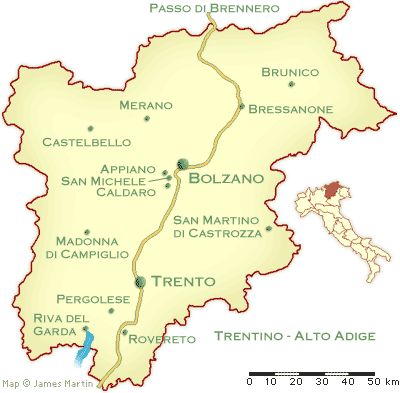 We
are on our way to Feldthurns in Sudtirol (South Tyrol), our base for a week
of hiking in northern Italy’s Trentino-Alto
Aldige region, where the majestic Dolomites form a gray-and-white backdrop
to every town and village. Our rental car follows that of Gunter’s brother,
Helmut, and his wife Anneliese, through the region’s main artery: Brenner
Pass Road. It is among the busiest in all of Europe—the primary north-south
route through the Alps. The
Brenner Pass runs south from Austria, follows the Adige River from Bolzano
to Trento, and continues southward on to Verona. We leave the autobahn (called
autostrada as we enter Italy) crammed with trucks from every European country,
to take the scenic route. Soon we stop to photograph Europe’s longest
bridge. I can only imagine how horrendous the drive through here must be in
the winter when the signs proclaim that chains and snow tires are required
The region’s mountains have been cut by glaciers into deep, broad valleys.
Many of these, such as the Feldthurns, face south, so they remain unusually
warm and sunny.
We
are on our way to Feldthurns in Sudtirol (South Tyrol), our base for a week
of hiking in northern Italy’s Trentino-Alto
Aldige region, where the majestic Dolomites form a gray-and-white backdrop
to every town and village. Our rental car follows that of Gunter’s brother,
Helmut, and his wife Anneliese, through the region’s main artery: Brenner
Pass Road. It is among the busiest in all of Europe—the primary north-south
route through the Alps. The
Brenner Pass runs south from Austria, follows the Adige River from Bolzano
to Trento, and continues southward on to Verona. We leave the autobahn (called
autostrada as we enter Italy) crammed with trucks from every European country,
to take the scenic route. Soon we stop to photograph Europe’s longest
bridge. I can only imagine how horrendous the drive through here must be in
the winter when the signs proclaim that chains and snow tires are required
The region’s mountains have been cut by glaciers into deep, broad valleys.
Many of these, such as the Feldthurns, face south, so they remain unusually
warm and sunny.
It is a path traveled for centuries. In 1991, the body of a man reputed to be 5,000 years old was found emerging from a glacier in Alto Aldridge. The frozen corpse wore leather boots, stuffed with hay for warmth, and was armed with a copper ice pick.
These paths became a major road network back in Roman days, when many of the region’s cities were founded. By the Middle Ages, Alto Aldridge had established its own distinctive culture under the Counts of Tyrol. Those counts had built the numerous castles that line the mountain passes.
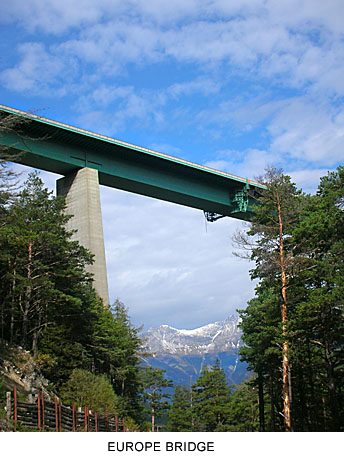
Tyrolean hospitality is legendary. The hundreds of guesthouses along the valleys are still built in the distinctive Tyrolean style, with rich timber balconies to take advantage of the winter sun and overhanging eaves to keep away the snow. I was captivated by the marvelous views during a visit there 15 years ago; now I look forward to exploring them at a more leisurely pace.
Sterzing (Vipiteno), Italy
What a wonderful stop to break up our drive to Feldthurns! We follow Helmut’s
vehicle as they pull into the parking lot above a little northern Italian
village. As I get out of the passenger side, I am already snapping photos
of the castle framed by the mountains, the church tower spiraling toward the
sky, and the medieval stone walls. Little did I realize that Helmut would
march us right through those walls into a charming Tyrolean village, complete
with cobblestone streets lined with chic shops and cafes.
We enjoy a tasty lunch of fresh, delicate pasta, and then walk the entire length of main street, majestic mountains always ahead of us, with the tall clock tower rising from the walls behind. It is my first glimpse of a northern Italian town, and I am extremely pleased that it will not be my last!
Insert Photos 02, 03, 04 of Sterzing.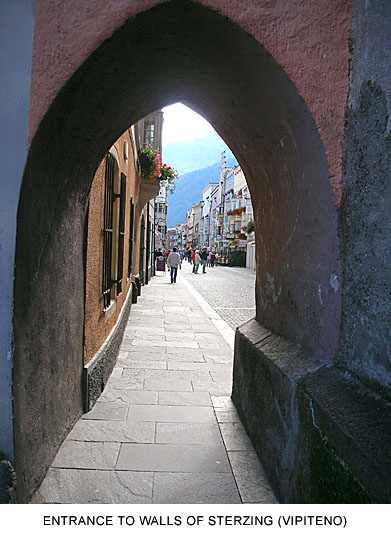

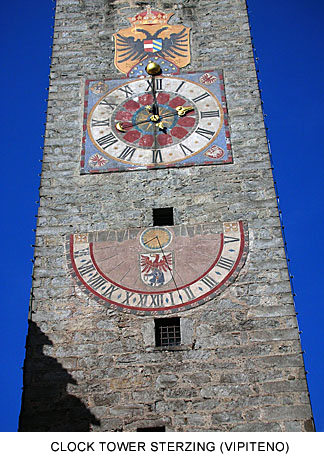
Feldthurner Hof
Panorama Wellness Hotel: Time for pleasure on the sunny side of the Alps,
says the brochure I pick up in the warm-wooded front lobby as we check in
for the week. Our hotel is where the mountains are a little closer, face to
face with the famous Geislerspitzen. The Dolomites dominate the panorama,
the brochure continues. www.feldthurnerhof.com
From the balcony off our second-floor room, framed with the typical boxes of rich red geraniums, we soak up the view below: It is a bucolic scene. Cows graze on hilly slopes, backed by mountains 3000 meters (9000 feet) high, dominated by the white, jagged peaks of the Geislerspitzen. I could spend all my time enoying herbal teas right here at the little oilcloth-covered balcony table, gazing, marveling, as fluffy clouds obscure, then unveil those peaks! But there is an invitation to a wine-tasting on the lower deck-- sponsored by a local vineyard, and followed by a five-course dinner. It is time to change clothes and get cracking…
During our week here, we enjoy the spa facilities, the bountiful German-style breakfast buffets, and the five-course Tyrolean/Italian dinners, all included in the “half-board” weekly rate. We also enjoy daytime walks down part of the mountain to the village of Feldthurns (Velturno)—still 850 meters above sea level, visits to the town church and castle, stops at local cafes and hotels for coffee and kuchen, after which we plod uphill to burn off all those calories.
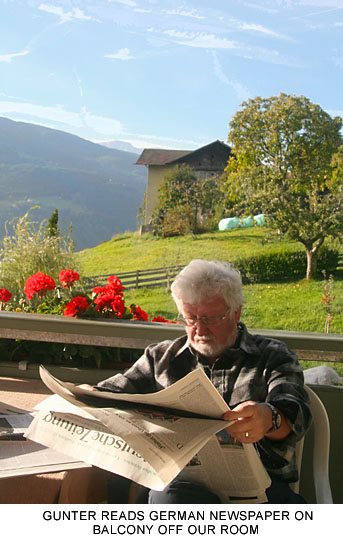
This is a family-owned and operated hotel and spa. I am amazed at how well the Dorfmann family runs their hotel and still manages to get along, cheerfully juggling their various duties as the situation demands. Bernard Dorfmann has the top job as head of the family, meeting and greeting guests, serving the wines and hors’de oeuvres, and pitching at the front desk. His wife, Anni, does the same and also manages the housekeeping staff. Daughter Julia runs the wellness center, including pools, Jacuzzi, saunas, steambath, massage rooms, and manicure/pedicure operations. Stefan can be found at the front desk, working the accounts. His brother Christian is a trained chef who serves everything from regional fare (Austro-German) to Italian delicacies, using fresh ingredients from local farmers. It is surely a place to be pampered and spoiled by the family after long days of hiking and sightseeing.
Meandering through Merano, October 1
Merano is another spa town popular with Austrians, Germans, and Italians.
On Corso Liberta, a street lined with chic shops and smart hotels, stands
the Kurhaus, a magnificent spa hotel built in 1914. It is now a concert venue.
We walk through the town on a sunny, mid-week day, still finding it full of
tourists sipping coffee and drinks at the many sidewalk cafes. Gardens line
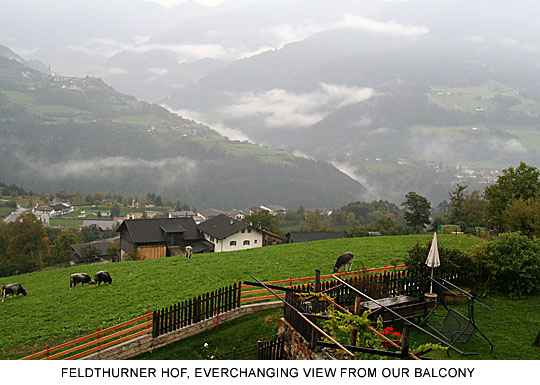
both sides of the Passino River, winding through the charming town. We decide to take the Passeggiata d’Estate (summer walk) on the river’s south bank and hike all the way up to the medieval Ponte Passino. The 15th century Castello Principesco was home to the Hapsburg Archduke Sigismund and is still furnished period style. Our walk takes us up the hill and back down through the village church and archway.

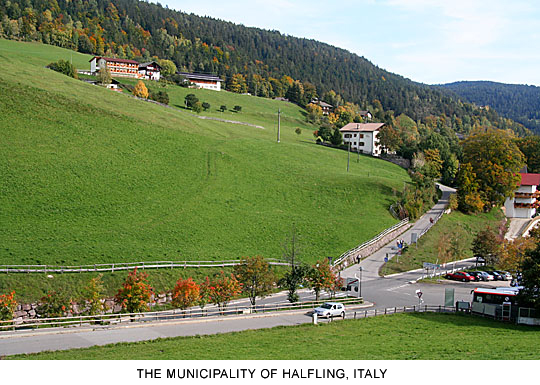 After
our walk through Merano, Helmut drives us up through a mountain pass, higher
and higher, until he stops at a car park in the tiny municipality of Hafling,
with a population of 721 (98% German-speaking) and an area of 27 square kilometers.
The name comes from the Haflinger breed of horses. Hafling consists of a church
and a few homes halfway up a hill, with a restaurant perched on top. Picturesque
farms with horses, cows, and sheep dot the rolling hills stretching higher
and higher into the
After
our walk through Merano, Helmut drives us up through a mountain pass, higher
and higher, until he stops at a car park in the tiny municipality of Hafling,
with a population of 721 (98% German-speaking) and an area of 27 square kilometers.
The name comes from the Haflinger breed of horses. Hafling consists of a church
and a few homes halfway up a hill, with a restaurant perched on top. Picturesque
farms with horses, cows, and sheep dot the rolling hills stretching higher
and higher into the 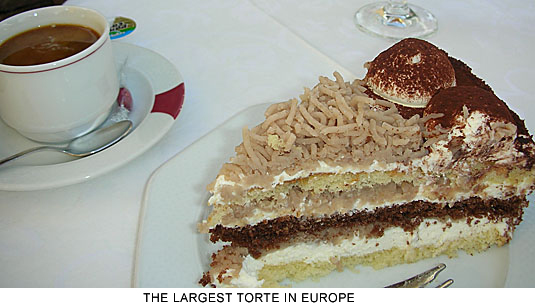 clouds.
“They have the largest single servings of cake I have ever seen,”
says Helmut as we sit down near a fountain on one of the two flower-filled
verandas. The four of us split one piece, but I can’t resist a chocolate-lathered
ice cream sundae as well.
clouds.
“They have the largest single servings of cake I have ever seen,”
says Helmut as we sit down near a fountain on one of the two flower-filled
verandas. The four of us split one piece, but I can’t resist a chocolate-lathered
ice cream sundae as well.
Insert photos 11 and 12
Mountain Walk, October 2
We drive, then hike, up toward what appears to be a quaint mountain hut in
the Italian Alps. But this is no small hut. Called Mair en Plun, its restaurant
expands onto a huge veranda—full of autumn hikers—facing majestic
view of the Dolomites. It has recently been remodeled and is now open for
ten months of the year, housing cross-country skiers and other travelers for
the Christmas holidays. Helmut orders a slab of speck (ham). 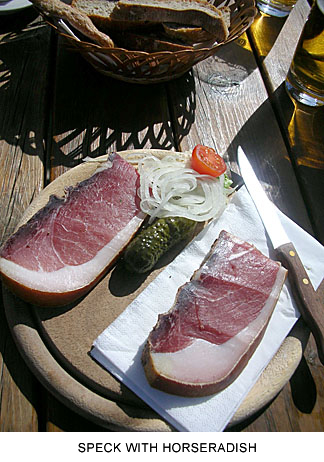 It
comes with bread, pickle and curls of fresh horseradish. If you have tasted
only canned horseradish, you don’t know what you are missing. Gunter
orders a German dish called kastanienkrapfen. It is like a potato pancake
with berry jam and powdered sugar. Hmm! There go the calories I burned trudging
up to this place! At every bend in the trail, as we hike back down the mountainside
to the car park, the majestic dolomites form a backdrop to bucolic scenes
of mountain farms.
It
comes with bread, pickle and curls of fresh horseradish. If you have tasted
only canned horseradish, you don’t know what you are missing. Gunter
orders a German dish called kastanienkrapfen. It is like a potato pancake
with berry jam and powdered sugar. Hmm! There go the calories I burned trudging
up to this place! At every bend in the trail, as we hike back down the mountainside
to the car park, the majestic dolomites form a backdrop to bucolic scenes
of mountain farms.
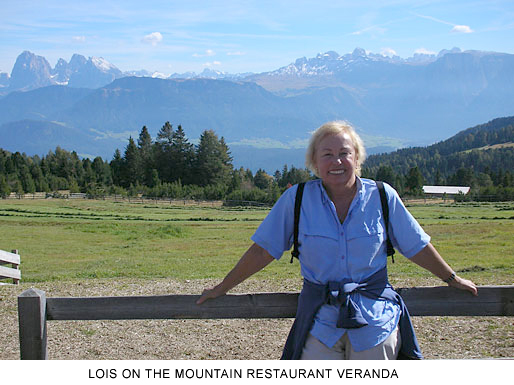
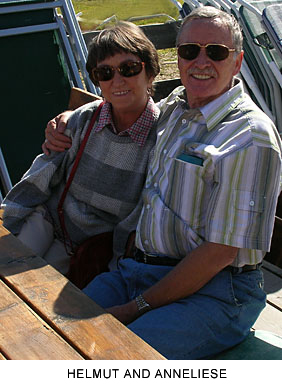
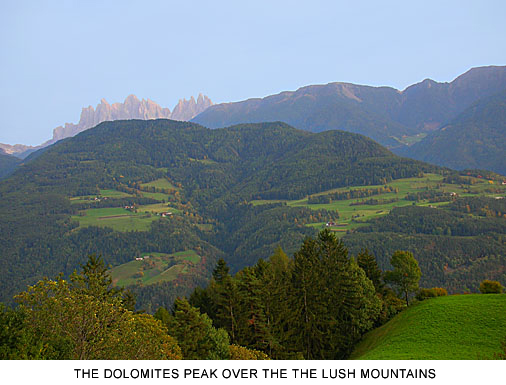
One Hundred Dogs Barking, October 3
Gunter’s cough that began in Munich, the night before our road trip,
is getting steadily worse. He seems OK, although tiring easily, during the
days, but his nights are filled with coughing that will not stop—so
bad that his chest and stomach hurt. Our relatives head back to Germany after
breakfast, so I begin a search for a local doctor. “He comes around
to the Feldthurns clinic from 4-6 PM every day. It is first come, first serve.
So be there early,” says Julia, who runs the spa. We are there already
by 3:40. Good thing, because the clinic had actually opened at 3:30 PM. The
small waiting room is already filled.
The doctor’s assistant comes out to the waiting room and announces:
“Those who only want prescriptions filled come first.” Half the
room files by. Good. Then the assistant calls those in the waiting room in
the order they arrived. No signing in. Just the honor system. But it works.
Simple and efficient. Like a vet’s office in the U.S.
The room empties quickly and more patients arrive. We are next. The swarthy,
curly-haired Italian doctor is wearing dark cotton pants and a checked long-sleeved
shirt, his stethoscope hung around his neck. He asks Gunter to bare his chest
and sit on the examining table.
“Your chest sounds like a hundred barking dogs,” he announces
in perfect English. He presses to find where it hurts. “You have spastic
bronchitis,” he continues in German. He swivels in his seat toward his
desk and begins to type, filling in Gunter’s name and home address.
He then hands him three prescriptions, all in Italian: ciproxin, an antibiotic,
cough syrup with codeine, and an expectorant. He also writes out for him the
name of an OTC anti-oxidant and acidophilus.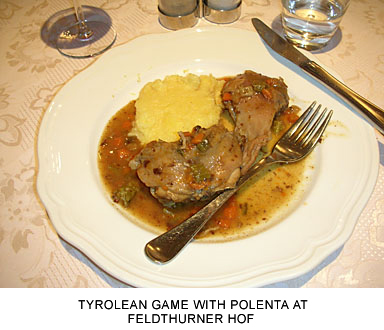
The following day is spent in coughing and partial recovery. “Well, if you are going to be sick, the good news is that we are at a spa…” I venture. I go down to the desk to add 2 more days to our reservation. By the next day, Gunter is watching German comedies on TV and laughing until the sharp pain in his diaphragm warns him to stop. So much for hiking the Dolomites and shedding some pounds. I swim and sauna and pare down the evening dinner by skipping the salad! The remaining four courses are to die for. The chef’s creations each night are just too tempting…
The Feldthurns Castle.
 By Friday afternoon, Gunter is feeling better, so we drive as far as we can
toward the castle, then hike the rest of the way, past a farm home with vineyards
clinging to the side of the mountain, piles of luscious red apples in wooden
slat boxes, and low-hanging branches laden with wine-hued berries. After the
farms, the small gravel path becomes much steeper, effective silencing any
conversations. We puff our way to the castle perched on its very own mountain
peak. We can understand how well protected were those Counts
of Tyrol. At the top, two castle churches adjoin the castle, one shuttered
tight with ornate iron scrollwork, and the second, for the peasants, open
to the elements. Here at the top, it is easy to feel close to God. We stop,
meditate and pray.
By Friday afternoon, Gunter is feeling better, so we drive as far as we can
toward the castle, then hike the rest of the way, past a farm home with vineyards
clinging to the side of the mountain, piles of luscious red apples in wooden
slat boxes, and low-hanging branches laden with wine-hued berries. After the
farms, the small gravel path becomes much steeper, effective silencing any
conversations. We puff our way to the castle perched on its very own mountain
peak. We can understand how well protected were those Counts
of Tyrol. At the top, two castle churches adjoin the castle, one shuttered
tight with ornate iron scrollwork, and the second, for the peasants, open
to the elements. Here at the top, it is easy to feel close to God. We stop,
meditate and pray.
Following the downhill hike to our car, we drive around curvy mountain roads to a little village where we stop for a refreshing apfelshorle for me and fruit tea for Gunter. Near the Gasthof is yet another church on a small hill. As we climb up to explore, the clock tower chimes to signal 5 PM, as it must have for centuries—time for the farm workers to head home from their fields.
Insert photos 19-24
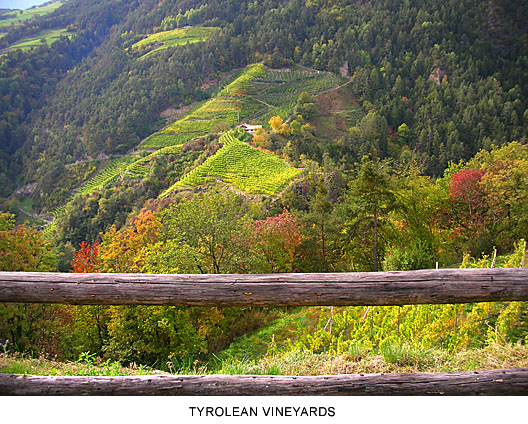
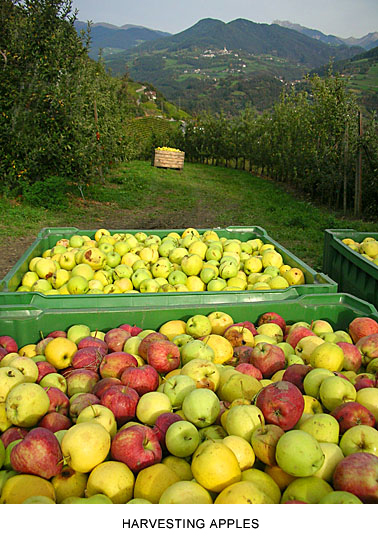
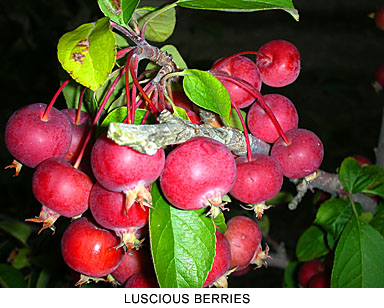
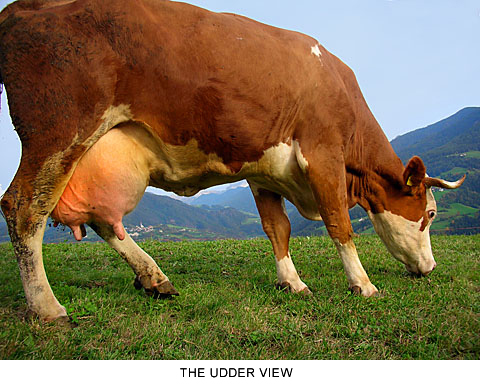
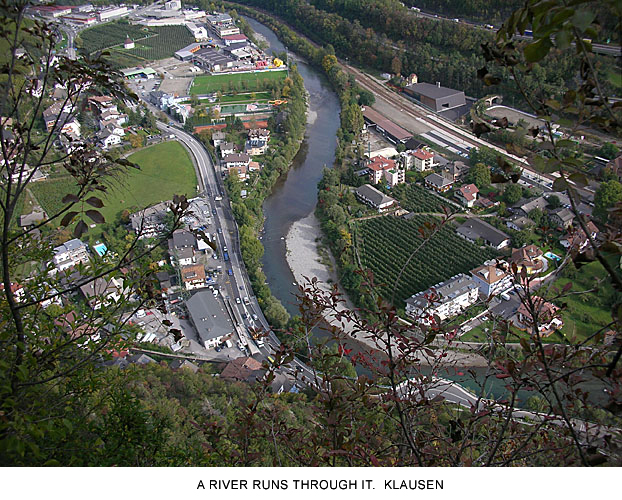
Saturday morning, clouds form below our balcony in the valley town of Klausen. They glide by the white cliffs, across the mountain pass. There will be no hiking on the “shady side of the Alps” today. There is a sharp clap of thunder as the rainstorm heads our way. No hiking on the “sunny side” either. We resign ourselves to a spa day, not minding some enforced rest.

The Bishops of Bressalone (Brixen)
The storm wends its way dramatically through the pass and then all is miraculously
clear on the sunny side. We decide to explore yet one more Italian town on
the Brenner Road before making our way to the Italian Lake District on Sunday.
The most ancient city in the Sudtirol is Bressanone (Brixen). This town of 18,000 is also the most beautiful and best preserved of the larger towns in the province. In a glorious mountain setting at an altitude of more than 1,800 feet (560 meters) it is pleasantly cool in summer, and has an average of three times as many sunny days as Vienna
For much of its history, prince-bishops ruled the town, with its narrow medieval
alleys, clustered around a huge baroque cathedral and palace. The town’s
many frescoes were painted way back in 1450, before Columbus discovered America.
Awestruck, we stroll through the frescoed arcade, separated from the church.
But what strikes us about the paintings from those times was that there were
no depictions of rural life—just the typical scenes from Jesus’
birth, miracles and crucifixion, mixed with scenes of creation, Adam and Eve,
and Old Testament stories. All of the artists back then made their living
from painting for the bishops, the only ones who had money to pay them for
their work. The ruling bishops were all powerful and ruled the area until
1803, when the bishopric was secularized and passed to Austria as part of
the Tyrol. The town then passed to Italy along with South Tyrol in 1919, and
remains a mixed German and Italian population. 
We enjoy minestrone goulash and speck dumpling soup for lunch, and after
exploring the chic shops that open again at 3 PM, we have coffee, apfelstrudel
and black forest cake at a café located on the 17th century Palazzo
Vescovile. What a pleasant way to wrap up our week of seeing the sights of
Sudtirol!














